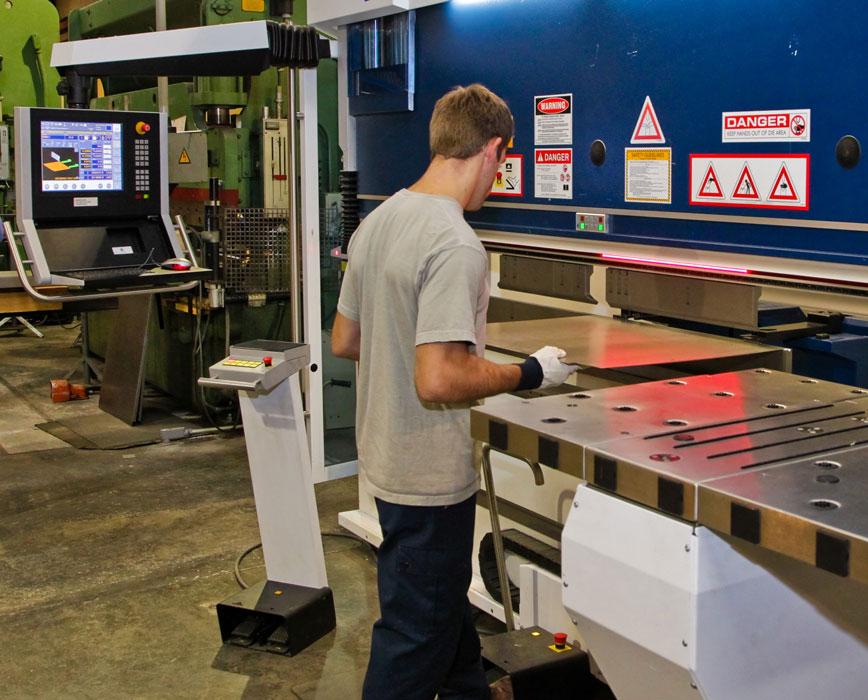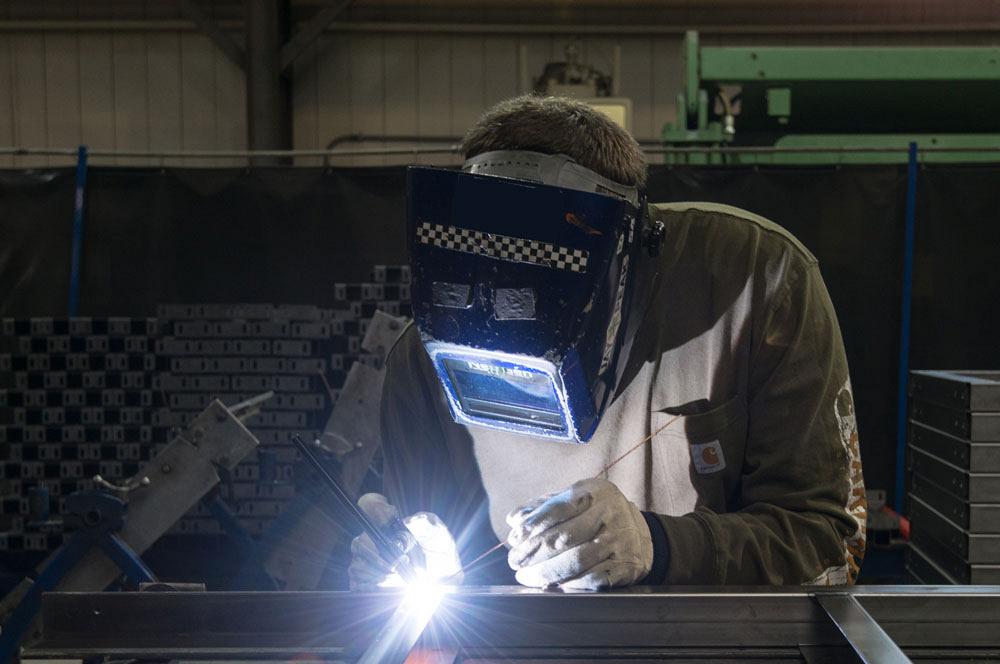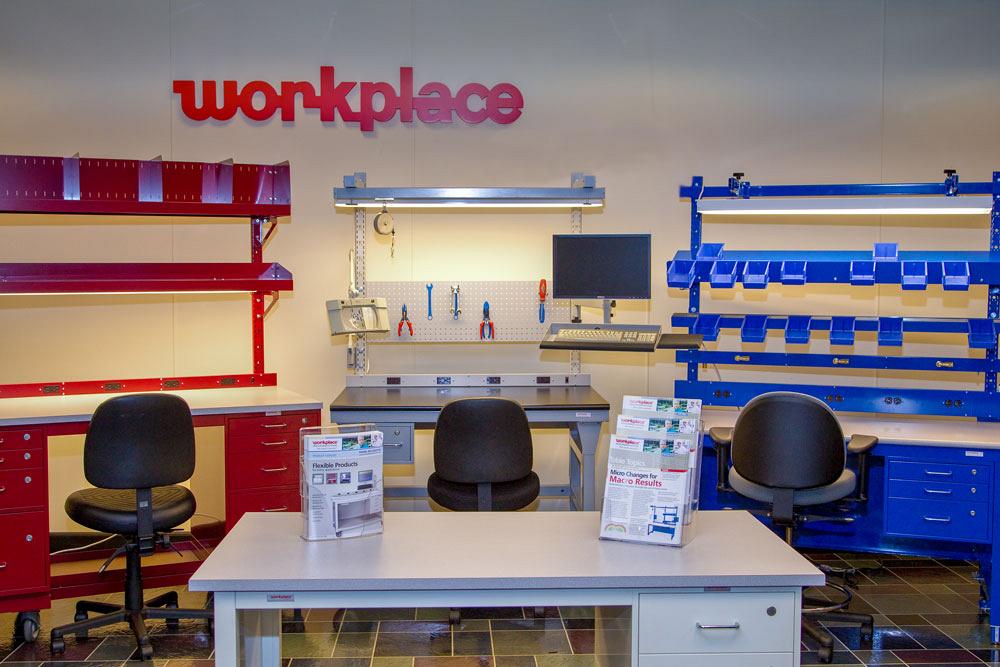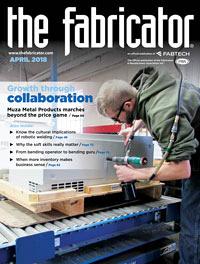Senior Editor
- FMA
- The Fabricator
- FABTECH
- Canadian Metalworking
Categories
- Additive Manufacturing
- Aluminum Welding
- Arc Welding
- Assembly and Joining
- Automation and Robotics
- Bending and Forming
- Consumables
- Cutting and Weld Prep
- Electric Vehicles
- En Español
- Finishing
- Hydroforming
- Laser Cutting
- Laser Welding
- Machining
- Manufacturing Software
- Materials Handling
- Metals/Materials
- Oxyfuel Cutting
- Plasma Cutting
- Power Tools
- Punching and Other Holemaking
- Roll Forming
- Safety
- Sawing
- Shearing
- Shop Management
- Testing and Measuring
- Tube and Pipe Fabrication
- Tube and Pipe Production
- Waterjet Cutting
Industry Directory
Webcasts
Podcasts
FAB 40
Advertise
Subscribe
Account Login
Search
Smart supply chain strategies lead to quick response
Subtle changes in inventory management put a company’s cash to work
- By Tim Heston
- April 10, 2018
- Article
- Shop Management

Formed and welded frame components are staged for painting and assembly at Workplace Modular Systems.
A proper workbench is all about having control of the work in front of you. Look down too long and you strain your neck. Reach too far in and you strain your back. Hunt for the right tools for too long and you’re strained for time. The best workbench limits all that and allows you to produce more in less time.
Such control had permeated the supply chain management style at Workplace Modular Systems (WMS), as James McEleney found in 2014 when he joined the company as president and CEO. As its name suggests, the company makes modular workplaces like desks and workbenches, all configurable to the nth degree. The second generation of family owners sold the business to private equity, which in turn brought McEleney in to manage the small manufacturer in Londonderry, N.H.
For decades the company had taken a Henry Ford style of supply chain management: To ensure optimal quality, control as much of the supply chain as you can. For this reason, the company performs most metal fabrication processes in-house, from laser cutting and punching to bending, gas tungsten arc welding (GTAW), and assembly.
Before 2014 it made virtually all other components (within reason) that went into a metal workbench. Some workbenches have flat-panel displays on adjustable arms. WMS didn’t make these displays, of course, but it did fabricate the arms that held these screens in place.
This isn’t a turnaround story. When McEleney came aboard, the ship was already sailing in the right direction. But it is a story about risk and especially how new leadership can bring a fresh perspective to managing that risk.
A Configure-to-order Business
McEleney is careful not to describe WMS as a “custom” business. Its products aren’t customized; they’re highly configurable. It’s a fine line, especially considering how highly configurable WMS’s workspace products really are. All the same, the company isn’t in the business of turning customer-supplied prints into a fabricated product.
“We configure to need,” McEleney said, “drawing on a vast array of predesigned components. We can satisfy almost any application requirements within a specified lead time.”
Those lead times have been getting shorter, too, down to 14 days for some quick-turn projects. Much of that lead-time reduction has come from changing how the company manages its risk—namely, outsourcing and inventorying.
WMS’s roots go back to the 1940s when Aime Huard began doing sheet metal work in the then rapidly evolving HVAC business. “Along the way some of his existing customers asked him if he could fabricate a workbench,” McEleney said. “Like any good entrepreneur, he said, ‘Of course I can do workbenches!’ Then he asked, ‘What’s a workbench?’”
Huard began building metal workbenches in an old mill in nearby Manchester. From that, the business grew. He developed good, decades-long relationships with people at Raytheon, Digital Equipment Corp., and elsewhere. From this work came WMS’s evolving library of configurable components.

Workers assemble workstation components on mobile assembly stations, which can be moved and reconfigured depending on the day’s product mix.
“We’re known for having the largest number of adaptable accessories in the industry,” McEleney said. A work desk might have a shelf on top for handling specialized instruments, a holder on the side to handle cables or wiring, a flat panel or white board to show work instructions or other information, perhaps holders underneath for drills and other power tools. The idea is to have everything within reach, allowing one to be as productive as possible.
WMS, which now employs 44 people, has never had to venture into the custom fabrication or job shop space. Some small and medium-sized product line manufacturers with in-house fabrication suffer from “lumpy” demand cycles, particularly if they sell to just one or a handful of markets. To even out the lumpiness, they sometimes attempt to sell excess fabrication capacity, turning themselves into a hybrid: part product manufacturer, part custom fabricator.
WMS doesn’t have this problem. The workspace business is naturally diverse. According to Mc-Eleney, the company doesn’t suffer from dramatic changes in demand, and the revenue diversity helps make the business sustainable.
The company sells its products into various sectors of the economy, including multiple manufacturing sectors—anyplace that needs a configurable, modular work desk for assembly, packaging, shipping, or office work. WMS uses some of its own products in its assembly and packaging operations. It ships (and sometimes assembles and installs on-site) products to various office, educational, and laboratory environments.
WMS’s highly configurable products also are somewhat immune to global competition. Customers could go online to order standard work desks, or perhaps desks with limited configurations. The parts for those desks could come from anywhere in the world. But WMS doesn’t play in this sandbox. Its products are so highly configurable that it would be difficult for global competitors to deliver them within a reasonable time frame.
Moreover, workbench components are large, so shipping costs play a factor in where the company can compete. “Our business, because of the weight of our products and the way they are designed, is North America-based. We do sell some products to Canada, but most of our customers are within the continental U.S.,” McEleney said.
Growth Through Supply Chain Management
When McEleney came to the job in 2014, he learned two things immediately. First, most of the company’s revenue came from repeat business and referrals. “We do have a huge diversity of customers over a wide range of industries, but our customers are also extremely loyal. Less than 10 percent of our production demand comes from customers who have never bought from us before.”
Second, WMS products last. “Our products really don’t wear out. We’ve got plenty of work solutions that customers bought from us that are more than 30 years old,” he said. “They’re still out there being used. Customers may replace a work surface, but the bench itself is fine.” The company produces replacement parts, but once a workstation is installed initially, there’s usually no reason to replace it entirely.
He added that the company has looked at going beyond a configurable product and offering purely custom options for certain customers. “The idea of customization has been something the company has evaluated over the years. We’ve asked ourselves, ‘Should we do this to fill a [revenue] softness for a particular year?’ But we also know when to say it’s just not right for us to do. Could we do it? Sure. Are we going to be economical? Probably not, because it’s just not our core capability.”
That core capability is offering a configure-to-order workspace, and when McEleney began at WMS in 2014, he looked at how the company could grow it. To that end, he looked to the supply chain.

The company’s press brakes have modern tooling systems, complete with lights above the toolholders that show the operator where the next bend goes, and a controller that runs a simulation of the bend sequence.
At the time WMS’s lead times varied greatly, usually between six and eight weeks. The company didn’t have excess inventory—quite the opposite, in fact. Being a family business averse to risk, managers didn’t want it. After all, you can’t make payroll with inventory.
The company had a “we do it all in-house” strategy. At one point in the company’s history, WMS’s machine shop even produced its own screws and other hardware. Nearly every component, metal or otherwise, came in as raw stock. This gave the company more control over quality, and the strategy worked. Loyal customers kept buying from WMS for a reason. They expected and received quality workstations.
By 2014, however, McEleney looked at the books and saw something that’s common among small, successful family businesses. It had lots of cash. This falls in line with industry research, including results from the annual “Financial Ratios & Operational Benchmarking Survey” published by the Fabricators & Manufacturers Association.
According to the 2017 survey—the respondents of which come mainly from small businesses—the average current ratio (assets divided by liabilities) is 4.9 and the average quick ratio (same thing with inventory taken out of the equation) is 2.62. Put simply, metal fabricators have plenty of liquidity.
This makes sense for a capital-intensive business with high revenue concentration. According to the 2017 survey, the average fabricator has four customers providing at least 50 percent of its revenue. But this isn’t the case with WMS, which is one reason that in 2014 McEleney started to put the company’s cash to use, with the goal of shortening lead times.
“It’s important for customers to have a predictable lead time. Occasionally customers may need something the next day, but for the most part, 14 calendar days is fine. When you get more than six or eight weeks out, unless it’s a major project, [such lead time] becomes a problem. And one of the ways we’ve managed to shorten lead time is to be willing to take on additional inventory.
“This strategy does take on a little more risk, because you’re tying up cash in inventory rather than having it sit in the bank. But having cash sit there also means it’s not working for you, either.”
He added that inventory, be it raw stock or purchased components, can be particularly valuable in WMS’s configure-to-order business model. If the company took an entirely custom approach, adding more inventory would come with more risk. But WMS has decades of sales data to draw from, so it knows which components are used regularly and which aren’t, and when.
At this writing, WMS does not powder coat work that isn’t tied to an actual order, considering customers can order any color they want. That said, it does prebuild certain common components to stock. These could include flat parts from its punch or laser and formed parts from its press brakes.
Inventory is carefully managed based on demand and overall throughput, governed by the constraint process, which itself is governed by the job routing. The company doesn’t run its laser just to run it, particularly if the work on that laser would just add to work-in-process (WIP) in front of forming or the GTAW work centers. A part’s design also plays a role, including how well it stacks, how much space it consumes, and the potential for damage.
The company also started purchasing (instead of making) some components, including those articulating arms. It also stocks motors for height-adjustable desk components as well as casters.
Pulling from controlled inventory in parts-supermarket fashion (an order “pulls” WIP stored in a certain location) has helped shorten response time, but it hasn’t mitigated the need for quick changeover. Modern press brakes and cutting systems help operators streamline changeover. Although these machines replenish WIP, the WIP level still is carefully managed. If people ran extra to save on setup, then the floor would be awash with excess WIP, which could turn a positive cash flow situation into a serious cash drain.
Attractively Robust
In a blog post on its website, WMS writes about five elements that make a workstation effective. First, its design must be ergonomic; it can’t force workers to compromise how they do their jobs. Second, it needs to be modular, with standard pieces fitting together in various configurations. Third, it must be flexible and easy to change. Fourth, those pieces must be available from suppliers. And fifth, the workstation needs to be “attractively robust.” As the blog states, “Workstations need to be rugged enough to take daily abuse on the factory floor, but also communicate the high-quality image that impresses visitors and makes workers proud to work here.”
Those five elements could apply to WMS’s business as a whole—as well as other fabrication businesses, for that matter. Business processes are refined, so workers can perform their tasks without compromise (ergonomics). Pieces of the business need to adapt to customer demands (flexibility) but those pieces must be anchored to a business’s core strengths. Those core strengths may be put together in different ways (modularity), but together they help a business respond quickly (availability) and grow. All this makes the business “attractively robust”—polished and professional to attract and retain talent, yet also strong to weather past and future economic storms.
WMS now takes on more inventory than it did, which has some risk. But according to McEleney, it also responds faster and produces more, with sales outpacing increases in head count. Ideally, this will make the manufacturer attractively robust for whatever lies ahead.
Photos courtesy of Workplace Modular Systems, https://workplacenh.com.
About the Author

Tim Heston
2135 Point Blvd
Elgin, IL 60123
815-381-1314
Tim Heston, The Fabricator's senior editor, has covered the metal fabrication industry since 1998, starting his career at the American Welding Society's Welding Journal. Since then he has covered the full range of metal fabrication processes, from stamping, bending, and cutting to grinding and polishing. He joined The Fabricator's staff in October 2007.
Related Companies
subscribe now

The Fabricator is North America's leading magazine for the metal forming and fabricating industry. The magazine delivers the news, technical articles, and case histories that enable fabricators to do their jobs more efficiently. The Fabricator has served the industry since 1970.
start your free subscription- Stay connected from anywhere

Easily access valuable industry resources now with full access to the digital edition of The Fabricator.

Easily access valuable industry resources now with full access to the digital edition of The Welder.

Easily access valuable industry resources now with full access to the digital edition of The Tube and Pipe Journal.
- Podcasting
- Podcast:
- The Fabricator Podcast
- Published:
- 04/16/2024
- Running Time:
- 63:29
In this episode of The Fabricator Podcast, Caleb Chamberlain, co-founder and CEO of OSH Cut, discusses his company’s...
- Trending Articles
AI, machine learning, and the future of metal fabrication

Employee ownership: The best way to ensure engagement

Dynamic Metal blossoms with each passing year

Steel industry reacts to Nucor’s new weekly published HRC price

Metal fabrication management: A guide for new supervisors

- Industry Events
16th Annual Safety Conference
- April 30 - May 1, 2024
- Elgin,
Pipe and Tube Conference
- May 21 - 22, 2024
- Omaha, NE
World-Class Roll Forming Workshop
- June 5 - 6, 2024
- Louisville, KY
Advanced Laser Application Workshop
- June 25 - 27, 2024
- Novi, MI




























